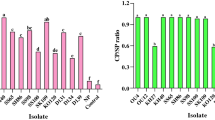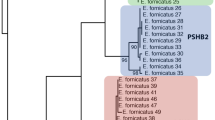Abstract
Tilletia Tritici and T. laevis are fungi which cause the well-known stinking smut disease or bunt of wheat. An affected wheat grain becomes transformed into a sack filled with several million, closely packed, minute, brown chlamydospores which, in the mass, have the odour of decaying fish. These spores become powdery and, under natural conditions, are passively dispersed by wind and rain. In the artificial process of threshing, the smut-balls are broken open and much of the chlamydospore-powder becomes adherent to the outer surface of the sound wheat grains. When smutty grains are planted in the soil, the fungus attacks the wheat seedlings and once more gives rise to the smut disease. Farmers in Canada and other countries treat the seed-wheat with formalin or some other poisonous substance. This kills the chlamydospores and greatly reduces the incidence of the disease.
This is a preview of subscription content, access via your institution
Access options
Subscribe to this journal
Receive 51 print issues and online access
$199.00 per year
only $3.90 per issue
Buy this article
- Purchase on Springer Link
- Instant access to full article PDF
Prices may be subject to local taxes which are calculated during checkout
Similar content being viewed by others
References
Cf. F. L. Stevens, "Plant Disease Fungi", New York, 1925, p. 213.
O. Brefeld, "Untersuchungen über Pilze", Heft 5, 1883, Taf. 12, Figs. 26 and 27.
F. Rawitscher, "Zur Sexualität der Brandpilze Tilletia Tritici", Ber. d. Deutsch. Bot. Ges., Bd. 32, 1914, p. 310.
Cf. A. H. R. Buller, "Researches on Fungi", London, vol. 3, 1924, Fig. 204, p. 505.
A. J. Kluyver und C. B. van Niel, "Über Spiegelbilder erzeugende Hefenarten und die neue Hefengattung Sporobolomyces", Centralb. f. Bakteriologie, Abt. 2, Bd. 63, 1924–1925, pp. 1–20, Taf. I and II.
Author information
Authors and Affiliations
Rights and permissions
About this article
Cite this article
BULLER, A., VANTERPOOL, T. Violent Spore-discharge in Tilletia Tritici. Nature 116, 934–935 (1925). https://doi.org/10.1038/116934a0
Published:
Issue Date:
DOI: https://doi.org/10.1038/116934a0
Comments
By submitting a comment you agree to abide by our Terms and Community Guidelines. If you find something abusive or that does not comply with our terms or guidelines please flag it as inappropriate.



